
As seen upper left - a front view of the Conrad Bumper Bass model #40224. According to
Conrad literature copyighted in 1973 by David Wexler & Co. Chicago, IL. this instrument features 21 nickel silver frets clear of the body with
mother-of-pearl top and side position markers on a rosewood fingerboard with a 303/8"scale length and an overall length of 421/2".
At upper right, and seen from the backside, literature goes on to state 'featuring a steel reinforced neck of three-ply hard rock maple' yet here
here again is a Conrad neck with a dark wood center laminate instead. One thing the bass does have in common with its guitar brethern is the presence
of two pickups. But unlike the guitar model they are spaced farther apart for more tonal variety. Unfortunately, this leaves less mass for the tongue
of the neck which almost certainly has to make them less stable compared to the Dan Armstrong · Ampeg bass.
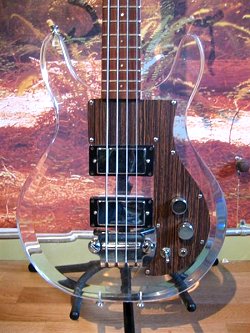
|
The Conrad bass model, unlike the guitar model, features a scratchplate that's shaped closer to the original Dan Armstrong scratchplates.
According to literature the Conrad bass features 'ultra-sensitive pickups with individually adjustable pole pieces' but as can be seen at left,
these pickups feature a solid (no holes) chrome cover over them. It is unknown if they are original to the instrument or not.
According to literature, 'the deluxe chrome plated bridge is adjustable for height', and while it lacks the rosewood saddle of the original Dan Armstrong
bass - it does appear that, like the Armstrong model, the saddle-piece could be slanted one way or another. Like the Conrad guitar model, the Bumper bass
utilizes all chrome speed knobs and, as stated in literature, a three-way toggle switch that switches between the pickups. Notice the lack of sculpting in
the cutaways.
|
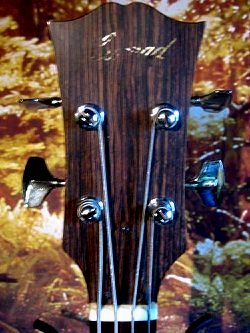
|
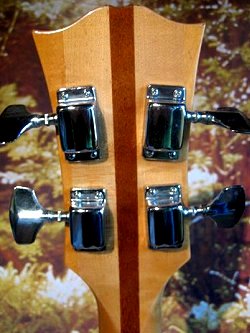
|
At upper left and seen from the front, the Conrad Bumper bass - like many such copies feature a Gibson 'moustache',
or 'open-book' style headstock. Sporting a thin wooden veneer that matches the scratchplate, it's adorned with the
Conrad name across the top. However, part of the name seems to be missing and it is unknown as to why.
As seen at upper right - the Conrad headstock from the backside, with multiple laminates making it up. But as mentioned earlier,
the most prominent laminate being a dark center one which runs contrary to their 1973 literature which states a 'neck of three-ply
hard rock maple'. While there are Bumper guitars & basses with all maple laminates, it's these models with different necks (and pickups)
that goes to show how inconsitant things were.
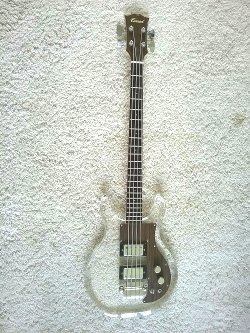
|
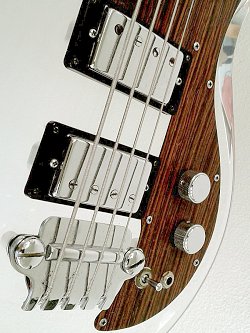
|
At upper left, another Conrad Bumper bass, and with the exception of some minor blemishes in the headstock (seen in enlarged view)
it appears to be in excellent condition. At right, the original factory hardware can be seen in detail. Notice how both the Conrad
guitars and basses have a scratchplate screw just to the upper right of the front pickup.
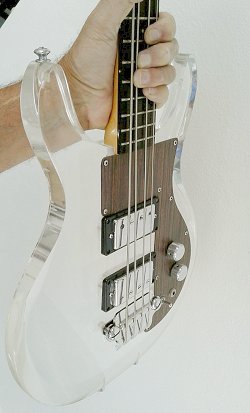
|
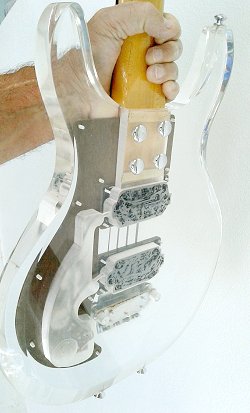
|
Above left, a nice touch. The acrylic body is adorned with oversized strap pegs. At upper right, an unusual dip, or curve can be
seen in the routing of the contol cavity as seen from the back. Like many instruments with bolt-on necks, notice a shim placed at
the bottom of the neck. Notice too, unlike the Conrad bass above, this bass has an all maple laminated neck with no mahogany center
laminate.
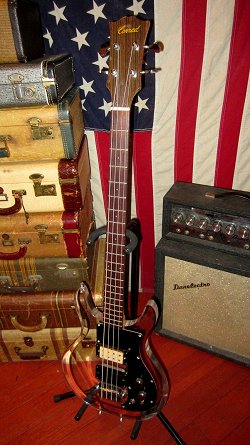
|
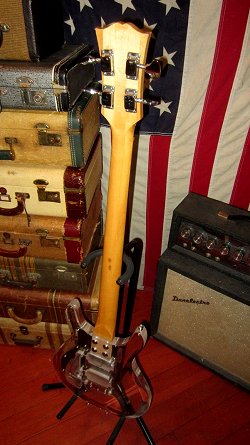
|
Another Conrad bass, this one with a replacement scratchplate and pickups. One looks like a DiMarzio but I can't make out
the other. At right, and like the Conrad bass above, this bass sports an all maple neck.
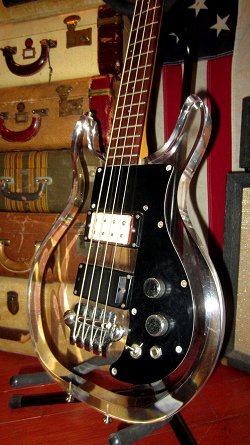
|
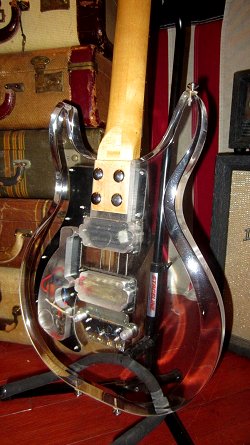
|
At left, it appears that oversized screws were used to secure the scratchplate to the acrylic body. At right, the small neck tongue and
lack of bevelling can be seen in the cut-aways.
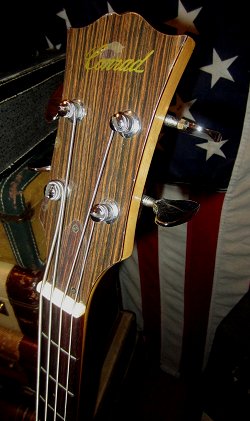
|
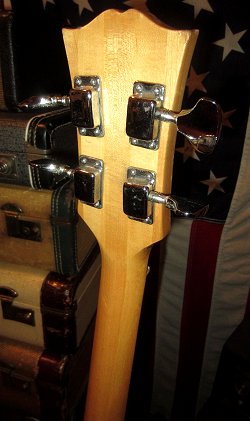
|
At left, another headstock with blistering in the finish, while at right, multiple laminates that make up the maple neck and headstock can be seen. But notice
here again, no mahogany center strip.
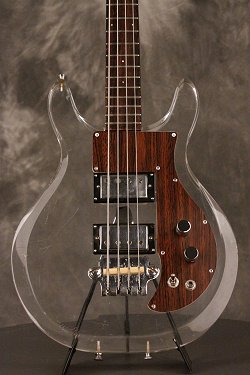
|
At left, a Conrad bass showing a scratchplate with the top two scratchplate screws missing and what looks like a replacement bridge.
|
At left and right, it's difficult to say, but the bridge appears to be made of ivory or maybe tusk.
At left and right, this bass has what I call a 'skunk-stripe' - simply meaning that this instrument's neck feautes a mahogany central laminate. Notice how
the back of the scratchplate is white. At first I thought it was shielding. Then the tailpiece caught my eye - specifically, the bottom. I couldn't quite
figure out what that was between the tailpiece and the acrylic body. It looked like it was rust or something.
At left, it turns out what I thought was rust is likely some form of epoxy. Apparently the tailpiece was lifting away from the acrylic body. This is a
weakness that's somewhat common among many of the bass copies of this era as the two tailpiece studs often times cannot withstand the tension and pull
of the bass strings, particularly a heavy gauged set.
At right, although the acrylic body is routed for it, the neck tongue on these instruments are very short. As such it makes for more tuning issues as well as
the necessity to use thicker gauged shims than a neck with a longer tongue in order to tilt the neck at a same given angle, if &/or when needed.
At left, I can't tell how high this replacement bridge is, but it's likely higher than the stock model. At right, It's highly unlikely that even returning to a stock
bridge would help lower the action on this bass, nor would even using flat washers as a neck shim. No doubt this is the result of the tailpiece lifting from it's mountings
(thus the epoxy). A new tailpiece/bridge is about all that could help this bass.
At left, severe wear and lifting of the clear coating of the headstock has occured, to the point where the Conrad name is barely visible. Notice the replacement
truss rod cover. At right, the backside looks fairly clean, save the upper left corner which seems to be roughed up and some of the finish chipped away.
copies menu
main menu
Names and images are TMand © Dan Armstrong / Ampeg. All rights reserved.
All other names and images are TMand © of their respective owners. All rights reserved.
|
| |

